
Only a few years ago, electric mobility seemed like a futuristic idea or a hypothetical concept. Nowadays, electric vehicles (EVs) are quickly becoming the new norm. Drivers around the world are choosing to drive electric, with the global EV fleet being set to surpass 20 million this year.
Only a few years ago, electric mobility seemed like a futuristic idea or a hypothetical concept. Nowadays, electric vehicles (EVs) are quickly becoming the new norm. Drivers around the world are choosing to drive electric, with the global EV fleet being set to surpass 20 million this year.
As the world switches away from internal combustion engines (ICE) cars, many people are starting to experience electric cars for the first time, both driving and charging them. And compared to the ever so familiar petrol pump, an electric car charging station can seem quite complex and daunting. To help you navigate through all these new developments, this article answers seven of the most frequently asked questions about charging electric cars.
1. How does electric car charging work?
Charging an electric car is a pretty simple process that can differ depending on the type of charger. Generally, every electric car comes with a charging cable and plug suitable for the specific car and country you live in. Most of the time, you will be able to plug the cable directly into a 3-pin home socket and charge your electric car straight off your home’s electrical network.
How does an electric car charging station work?
Charging at home via a home charging station and charging at a charging station on the go works quite differently. Whilst it can differ from station to station, the general process is as follows:
- Identify yourself to the charging station: this may be through a mobile app, an RFID tag or card, or even using contactless credit or debit card.
- Plug the charging cable into the vehicle and the station: some stations come with built-in cables, in which case, you can plug directly into your car.
- Begin charging: you should see confirmation that you are charging on your vehicle's display and the charging stations indicator lights.
- End the charging session: once charged, you can end the charging session via the station or mobile app, depending on how you started it.
However, this manual authentication process may soon be a thing of the past. A new international standard known as Plug & Charge (ISO 15118) provides a direct communication interface between chargers and EVs, allowing a charging station to automatically recognise and identify your car.
How do you pay for charging an electric car?
When charging at home, the electricity used by your electric car will simply be added onto your next electricity bill. When using a public charger, payment depends on your mobile service provider. Often, charging costs are added to a monthly bill based on a contract or subscription, or, in some cases, can be paid on the spot by card.

2. What powers electric car charging stations?
All around the world, electricity grids work on alternating current, known as AC power. As the name suggests, the electrical current alternates, or changes direction, a given number of times per second. In contrast, direct current, known as DC power, flows at a fixed rate. Whilst electric car chargers come in many different shapes and sizes, the main difference is whether they provide AC or DC power.
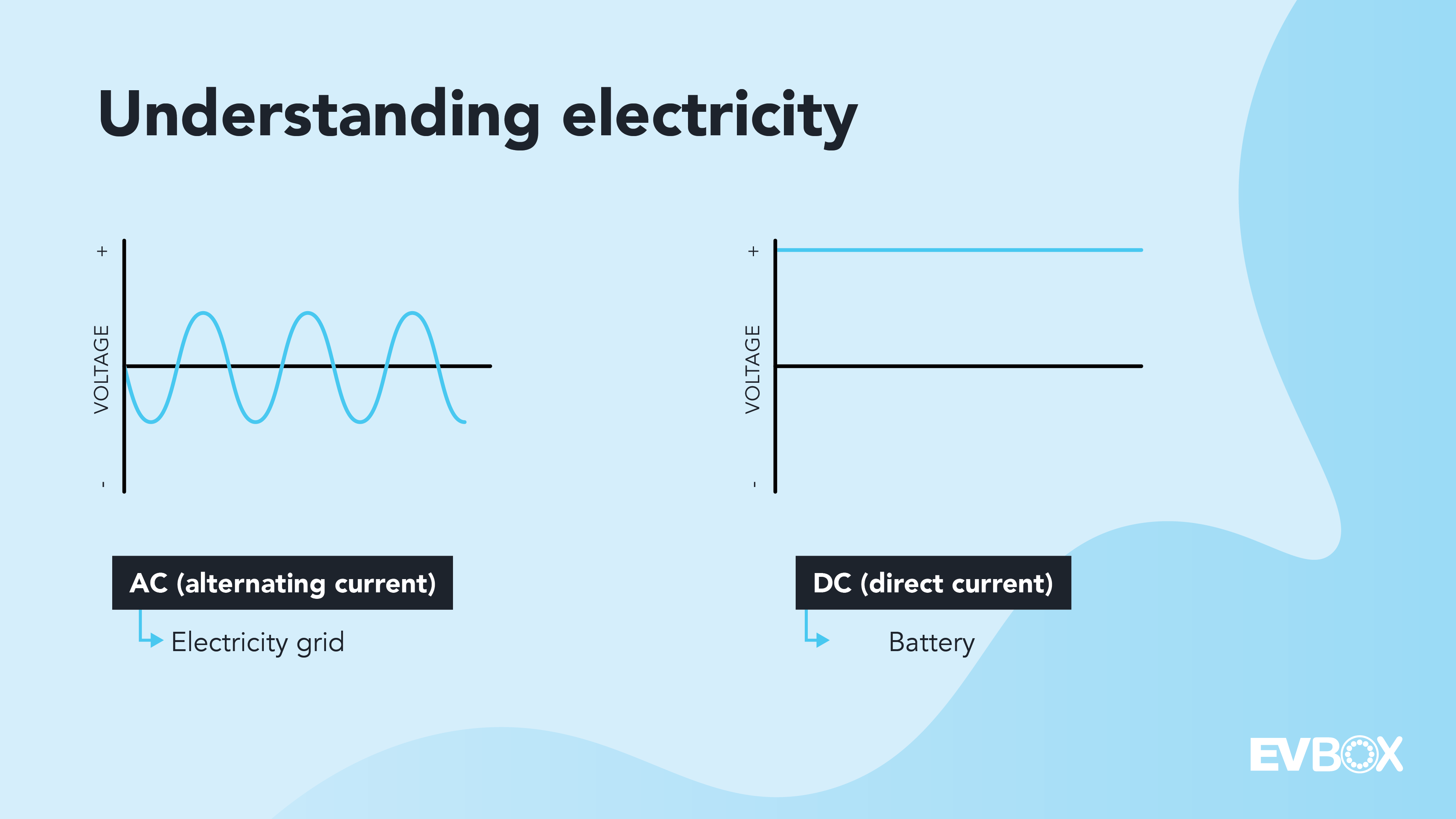
AC vs DC
All batteries, including those in electric cars, store DC power, which means that AC power coming from the grid must be converted. It’s not a question of if, but rather where this conversion happens that highlights the key difference between AC and DC chargers.
AC chargers are the most common (and generally slower) type. Without getting too technical, this is because the conversion takes place inside your vehicle and is limited to the power it can process. In most cases, EVs can reach up to 11 kW or 22 kW of AC charging power.
With DC charging, the electricity is converted from AC to DC by the charging station before it reaches your car. This allows it to bypass the car’s slower onboard converter and achieve much higher outputs, up to 350 kW as it feeds power ‘directly’ to the battery. As a result, charging an electric car with a DC charger takes mere minutes rather than hours. However, DC charging infrastructure is much more expensive and bulky, making it unsuitable for most residential, commercial, and municipal environments.
If you’d like to learn more about the difference between AC and DC charging, check out our detailed blog on the topic.
%20(1).png?width=960&name=Understanding%20electricity%20(2)%20(1).png)
3. How long does it take to charge a car battery?
Another common question that many prospective EV drivers have is about the time it takes to charge an electric car. The charging speed for any given car and situation depends on a variety of factors such as the battery size, the car and chargers’ charging capacity, and even the weather.
One of the main determinants of charging time is an electric car's battery size. Just as a large fuel tank takes more time to fill up, the larger the battery, the longer it takes to charge.
Another important factor that will affect an EV’s charging time is the battery’s state of charge (SoC). Because of their chemistry, batteries can accept more power at lower charge levels. As they get closer to 100% SoC, the charging power, and thus charging speed, slows down considerably. So, whilst charging an electric car from 20% to 70% might only take a few minutes, charging from 70% to 100% will take substantially longer.
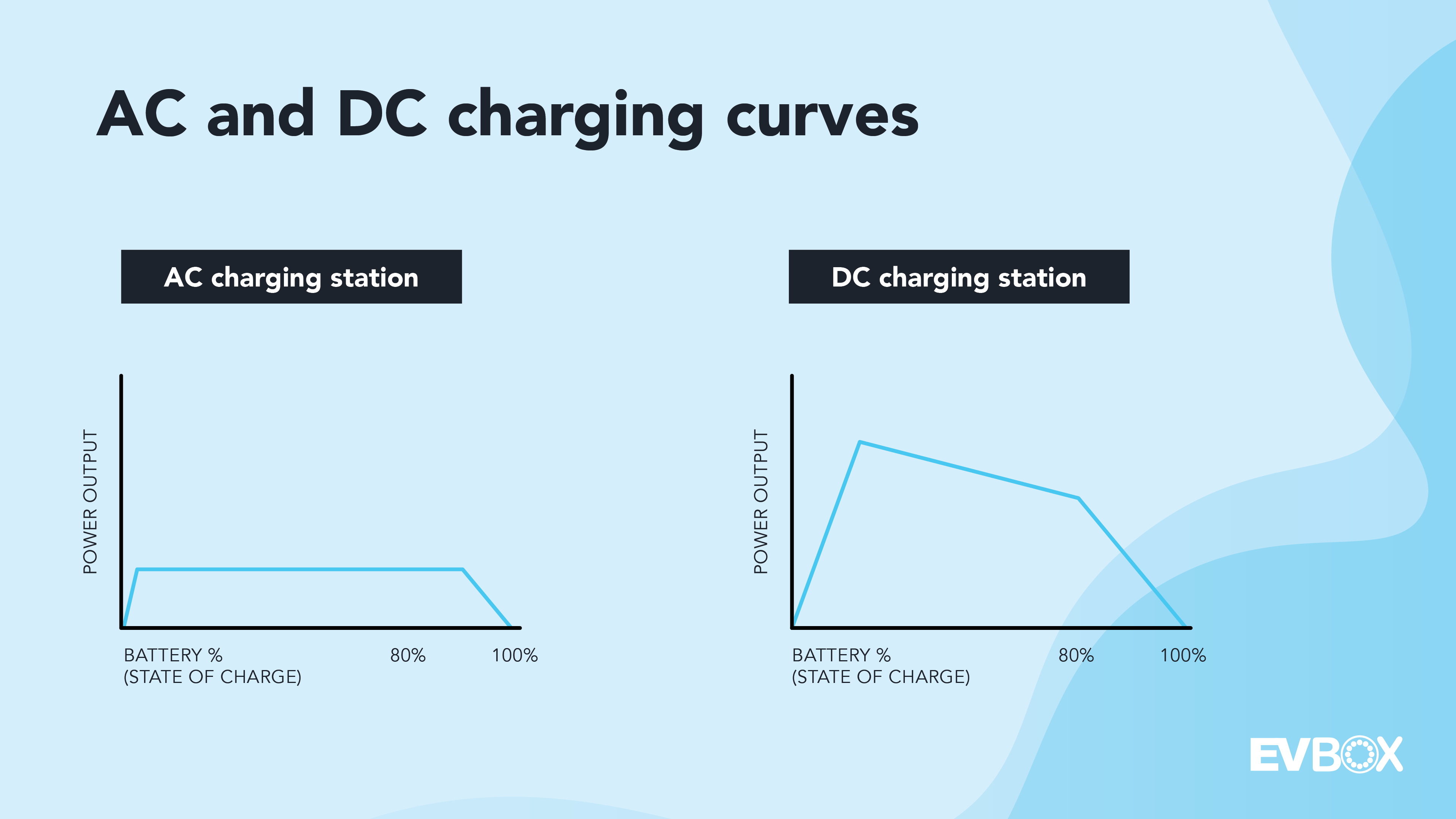
Beyond battery capacity and SoC, another element influencing charging time is the car’s charging capacity. Not all electric cars accept the same charging power: while some may be able to take up to 350 kW fast charging, many are limited to much lower power inputs, often between 100 kW and 150 kW. The same applies to slower AC charging. Whilst the theoretical maximum charging power is 22 kW, many cars can only receive 7.4 kW or 11 kW.
Linked to the car’s charging capacity is the charger’s charging capacity—in other words, how much power it can provide. Broadly speaking, there are 3 types of charging stations.
- Level 1: these chargers are the slowest and most common type. They can be connected to wall sockets at home and deliver up to 2.3 kW.
- Level 2: these chargers provide higher speeds but require professional installation. They are the most common type found in residential, commercial, and municipal settings. Most level 2 chargers deliver at least 7.4 kW or 11 kW, with some capable of 22 kW.
- Level 3: these chargers, also known as DC or fast chargers, deliver the most power and the highest charging speeds. They do, however, require bulky transformers and are not cost-effective for residential and most municipal uses. The highest-rated level 3 chargers can deliver 350 kW, although lower outputs such as 50 kW, 125 kW, and 150 kW are more common. At those rates, most electric cars can charge up to 80% in less than an hour, sometimes even as little as a few minutes.
Finally, weather conditions, in particular, temperature, can have an impact on the charging speed. Indeed, batteries have a narrow optional operating range of around 21°C. If temperatures are significantly higher or lower, the battery will use some energy to heat or cool itself, increasing the time it takes to charge it.
Electric car charging speeds are highly variable, and we’ve only just scratched the surface of the topic. For a more detailed explanation of electric car charging times, check out our blog.
4. How much does it cost to charge an electric car?
Charging times are not the only new concept to get to grips with as a new EV driver. Another important consideration is cost. As with charging times, costs vary greatly depending on your location, electricity provider, and tariff, just to name a few. However, the two key determinants of charging costs are the price per kWh of electricity, and the size of your vehicle's battery.
Whilst electricity prices vary from country to country, in the UK the average price per kWh is currently £0.28. Based on these prices, an electric car with a 50 kWh battery, such as the standard range Tesla Model 3, would cost around £14.00 to charge from 0% to 100% at home. Public charging stations, and especially DC fast charging stations, often markup the price of electricity, so a full charge using them will cost more.
Regardless of your location, charging your electric car at home will likely increase your electricity bill—unless you generate your own electricity using solar panels, for example. Still, the cost of the electricity to power your electric car is far less than what petrol or diesel would cost. For a complete overview of electric car charging costs, check out our blog.
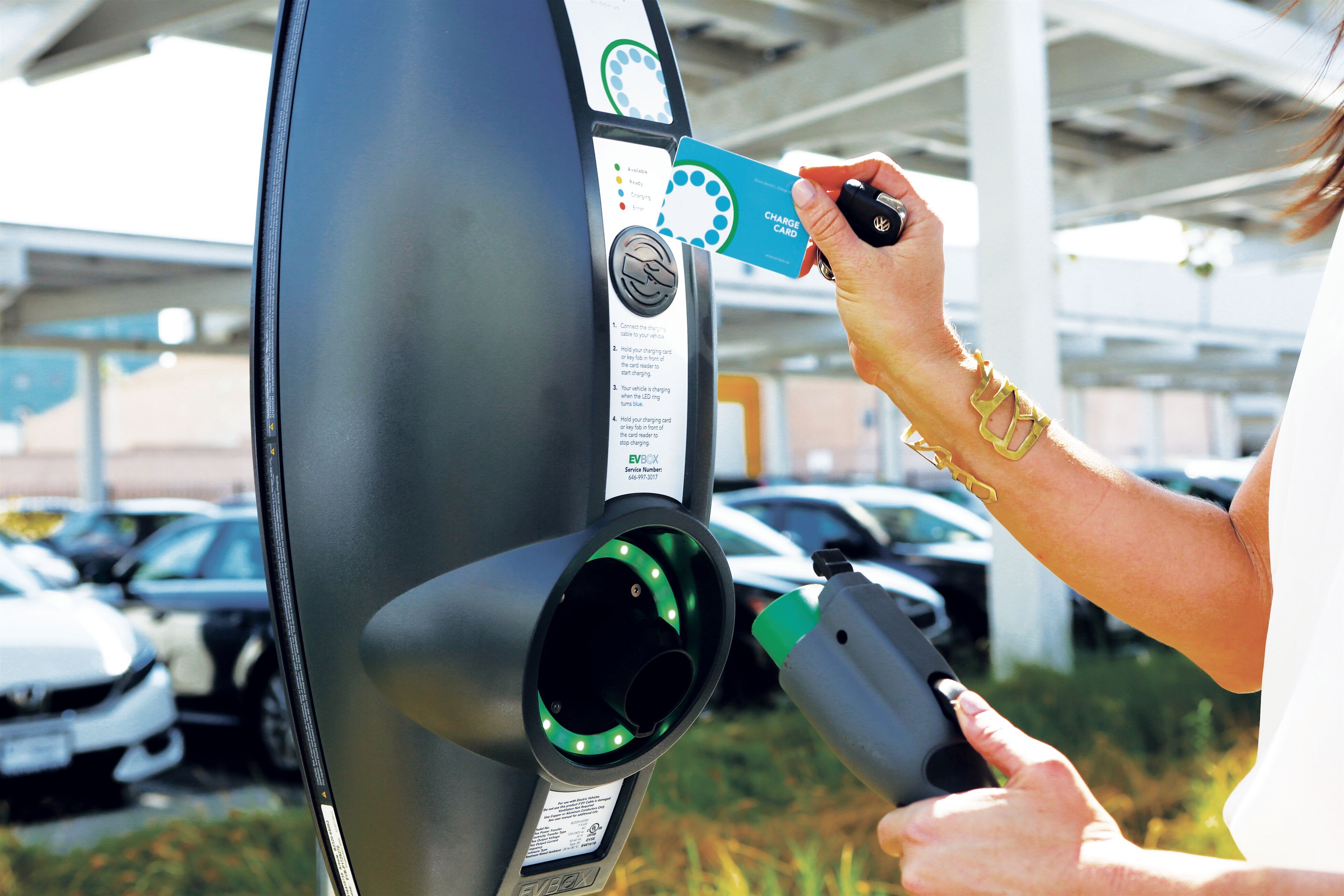
5. How often do you need to charge an electric car?
Compared to a petrol or diesel car, which only needs a refill every few days or weeks, a question many new EV drivers have is how often they will need to charge their electric car. As with the previous questions, the answer depends greatly on your driving habits and electric car range.
Should I charge my electric car every night?
The answer to this question depends, but looking at the average driving behaviour and the growing range capacity of electric cars, the answer is no.
Whilst the range of an electric car varies greatly, the current average is around 203 miles on a full charge. The average daily car mileage of drivers is 20 miles in the UK. Taking these average numbers, you would only need to charge your electric car fully approximately once a week. Of course, if you drive more or your car’s range is significantly lower, you’ll need to plug in more often. Even then, an electric car will typically last multiple days before needing a recharge.
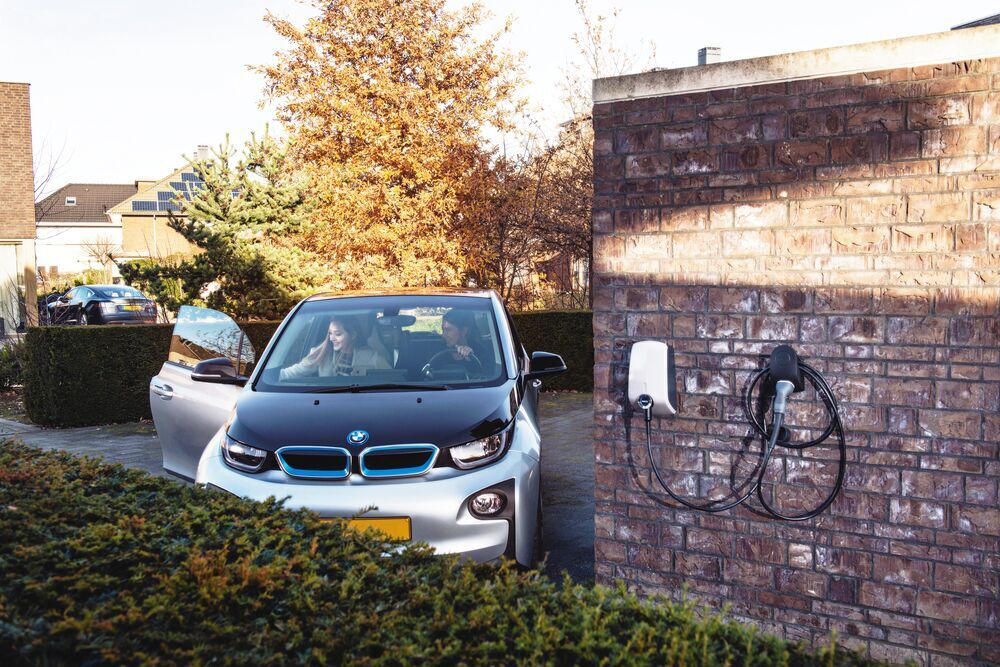
6. Where can I charge my electric car?
Driving an electric car can be very different from driving a fossil fuel-powered vehicle, and one of the ways it stands apart is in terms of the possible charging locations. Unlike petrol or diesel, electricity is available almost anywhere, meaning there are nearly endless possibilities to charge your electric car.
Of course, a key benefit of owning an electric car is waking up in the morning and starting the day with a full charge. According to our Mobility Monitor report, home charging is the most popular method of charging amongst EV drivers in the UK, with 65% regularly charging at home. Supermarkets are the second most popular charging location, with 44% saying they regularly charge there, and another 40% charging regularly at their workplace. The workplace is closely followed by service and petrol stations with 38%, and shopping centres at 27%, and finally 25% regularly charging in public and commercial car parks.
As the above data shows, the benefit of electric cars lies in their versatility—charging locations adapt to your needs, lifestyle, and vehicle usage.
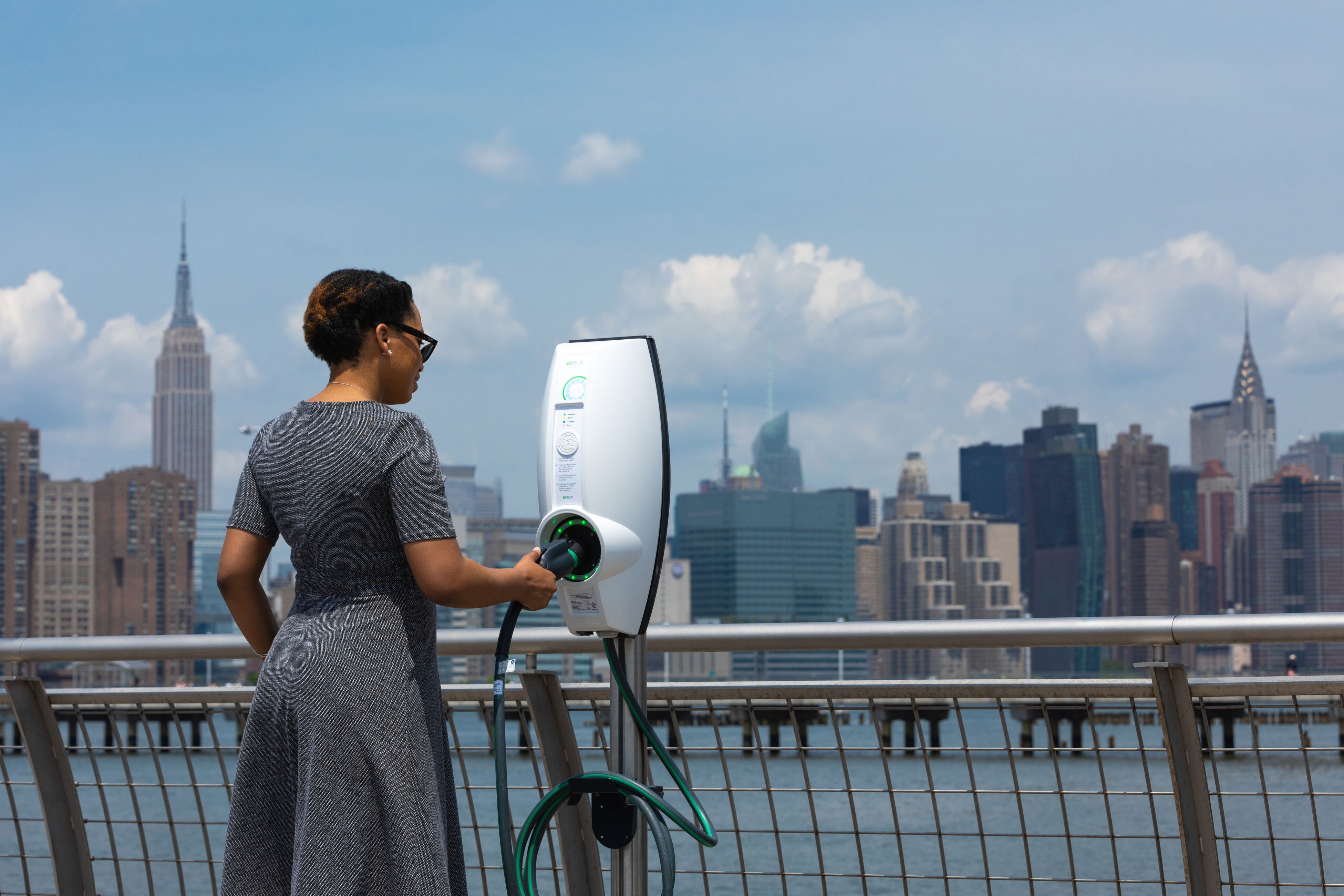
7. How much maintenance does an EV charger need?
If you’re thinking of investing in an electric car charger, you may be wondering: how much maintenance does a charger need? In most cases, the answer is very little.
For level 1 and level 2 chargers, the most maintenance you’ll typically need is an occasional quick check for any damage to the cables and plugs to ensure they’re in good working order. With everyday use, these chargers are designed to last for years before they require servicing. If you experience any problems with your charging station, we recommend you to contact your supplier.
For publicly accessible level 2 or level 3 chargers, the required maintenance depends on their use and location. Cables, plugs, and the charger itself should be inspected regularly to check for any damage and ensure good operation. Touch screens, card or RFID readers, and software systems also need to be checked and updated regularly.
Generally, electric car charger manufacturers offer extended warranties and service plans for a yearly fee, which include preventative maintenance and quick repairs if something goes wrong. However, with new connectivity and modularity features built into modern chargers, problems can often be diagnosed remotely.
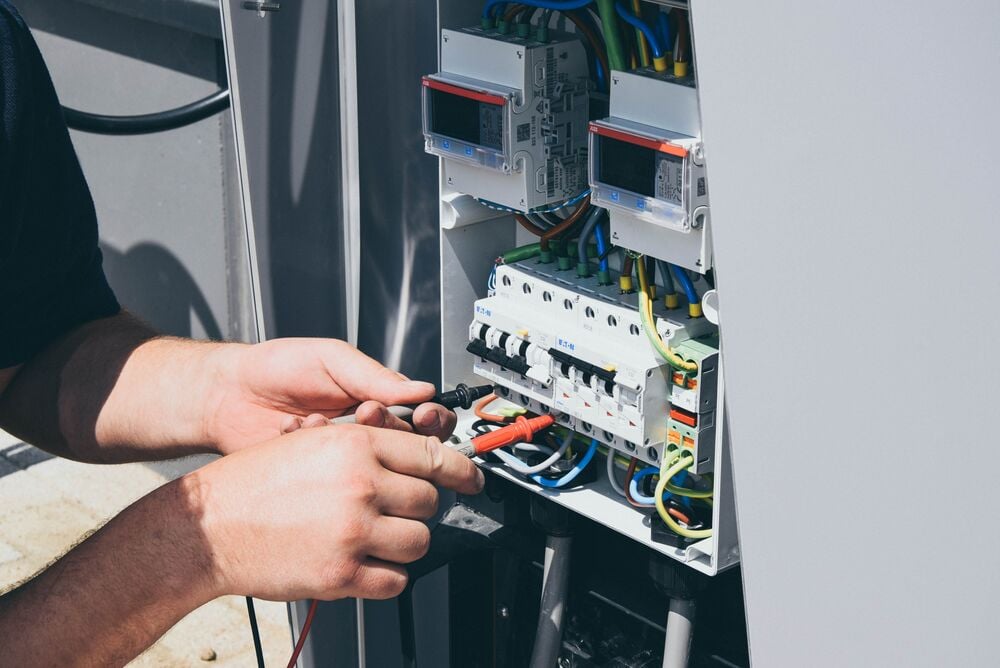
Switching to electric mobility
The decision to get an electric car is a consequential decision that requires some habit changes compared to owning a petrol or diesel car. Charging an electric car, in particular, is an entirely different process compared to refulling, but one that can offer increased flexibility and adapt to your lifestyle.
We hope the above questions have helped answer some of your doubts about electric car charging. If you want to know more, or have any unanswered questions, check out our complete guide to electric car charging which offers a comprehensive overview of the topic.
Related articles
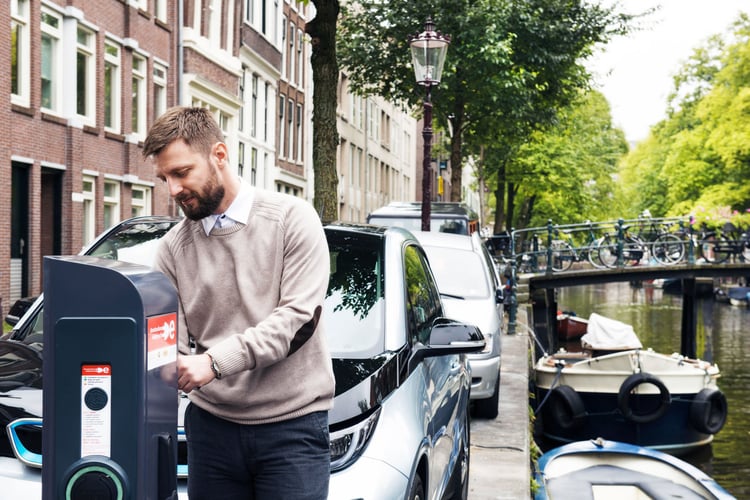
7 FAQs about electric car charging
Only a few years ago, electric mobility seemed like a futuristic idea or a hypothetical concept. Nowadays, electric...
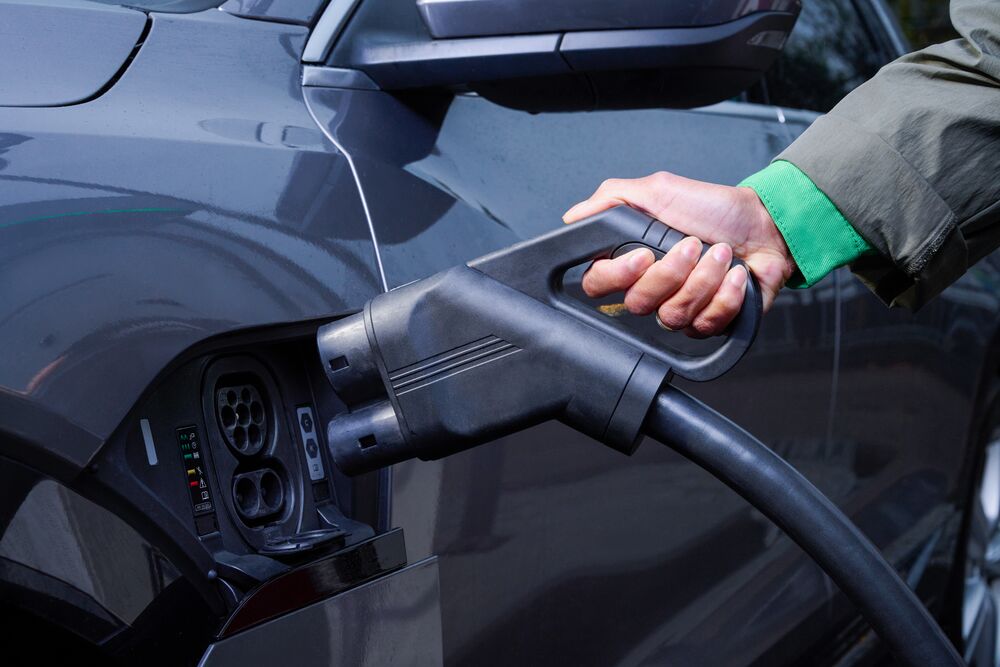
Electric car charging cables and plugs explained [2023 update]
Last updated on December 8th, 2023 Charging an electric vehicle (EV) is not a one-size-fits-all endeavor. Depending on...

Where to charge an electric car?
Today, nearly half of all prospective new car buyers are thinking of going electric. Lower prices, wider model variety,...